On the morning of July 6, 2013, an Asiana Airlines Boeing 777 was operating flight 214 from Seoul to San Francisco. However, due to the flight crew’s mismanagement of the final approach, the aircraft stalled and crashed in San Francisco, marking The Boeing 777’s First Fatal Crash since the aircraft type entered service in 1995.
Flight Details
The Boeing 777-200ER with registration HL7742 was operating Asiana Flight OZ214 from Incheon International Airport, South Korea to San Francisco International Airport, United States. Flight 214’s crew consisted of Captain Lee Jeong-min, who had 12,307 total flight hours, including 3,208 hours in the Boeing 777. The 49-year-old captain filled the dual role of a check/instructor captain and pilot in command. He was accompanied by Captain Lee Kang-kuk, who had 9,684 total flight hours, but only 33 flight hours on type.
Captain Kuk was receiving his initial operating experience (IOE) training and was halfway through Asiana’s IOE requirements. During the crash, Captain Kuk was the pilot flying (PF) whereas Captain Min was the pilot monitoring (PM).
Also, onboard the flight was relief First Officer Bong Dong-won and relief Captain Lee Jong-joo. At the time of the incident, the relief F/O was observing from the cockpit jump seat, whereas the relief captain occupied a business-class seat in the passenger cabin. There were 291 passengers and 16 crew members onboard the aircraft including 12 flight attendants.
On that day, Captain Kuk was making his first landing at San Francisco International Airport and was being supervised by Captain Min, who was on his first flight as an instructor.
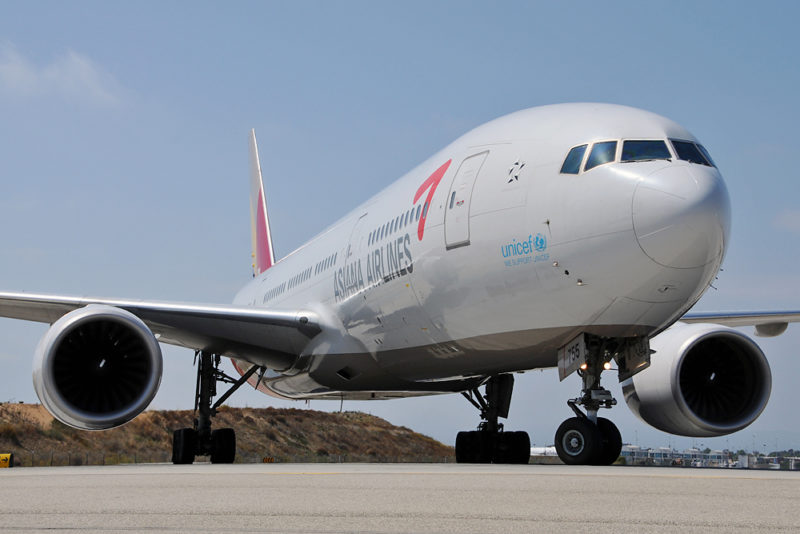
Approach To San Francisco
Continuing uneventfully, Captain Min reported that he did not observe any issues with Captain Kuk’s proficiency during the flight’s takeoff, climb, and cruise portions. Visual meteorological conditions prevailed, and an instrument flight rules flight plan was filed.
Flight 214 was vectored for a visual approach to runway 28L at San Francisco and it intercepted the final approach course about 14 nautical miles from the threshold at an altitude slightly higher than the desired 3° glide path. This placed the flight crew in position for a straight-in visual approach. However, after accepting air traffic control’s instruction to maintain 180 knots to 5 nm from the runway, the flight crew made a critical error in managing the aircraft’s descent, causing it to be well above the desired glide path upon reaching the 5 nm point.
Despite the flight crew’s difficulty to correct the aircraft’s altitude and capture the desired glide path, they continued the approach but struggled to manage the descent as the approach continued. In a bid to increase the aircraft’s descent rate and capture the desired glide path, the pilot flying (PF) selected an autopilot (A/P) mode (flight level change speed [FLCH SPD]), but instead of descending, the auto flight system initiated a climb since the aircraft was below the selected altitude. This prompted the PF to disconnect the A/P and move the thrust levers to idle, which changed the autothrottle (A/T) to HOLD mode, a mode in which the A/T does not control airspeed.
Subsequently, the PF pitched the aircraft downwards and increased the descent rate, but none of the crew members noticed the change in A/T mode to HOLD.
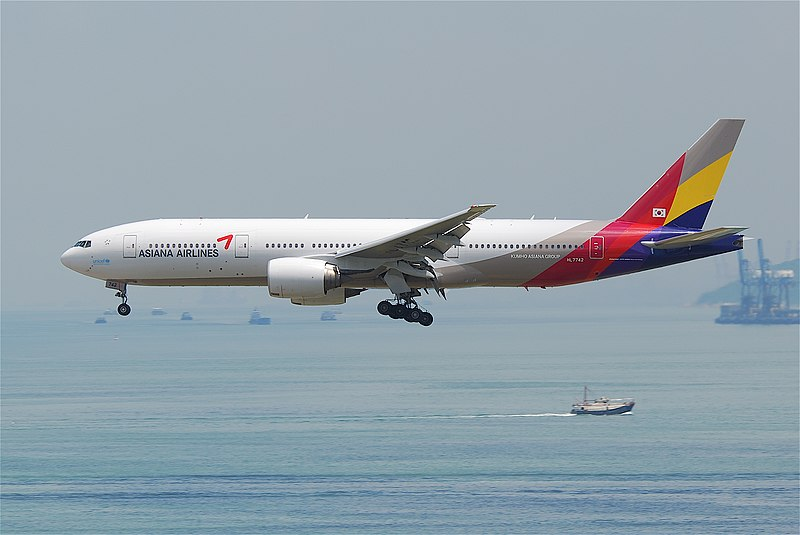
Go-Around?
As the aircraft reached 500 ft above airport elevation, Flight 214 was slightly above the desired glide path and the approach was not stabilized as the descent rate was well above the required rate. Additionally, the airspeed had just reached the proper approach speed of 137 knots, but the thrust levers were still idle, and the descent rate was well above the rate needed to maintain the desired glide path. Based on these indications, the flight crew should have initiated a go-around, but they did not do so.
As the approach continued, it became increasingly unstabilized as the aircraft descended below the desired glide path; as indicated by the precision approach path indicator (PAPI) displaying three and then four red lights. Despite the decreasing airspeed trend and the flight crew’s awareness of the low airspeed and path conditions at about 200 ft, they did not initiate a go-around until the aircraft was below 100 ft, leaving it with insufficient performance capability to accomplish a go-around.
The flight crew’s insufficient monitoring of airspeed indications during the approach was caused by various factors, including expectancy, increased workload, fatigue, and automation reliance. Flight 214 was less than a minute from the runway when some of the passengers realized that something was wrong as the aircraft was too low.
Copilot Min: Speed, Speed
Copilot Min: Go Around
Copilot Min: Go Around, Go Around
As the crew decided to go around while the aircraft was too low, due to insufficient performance capability, the main landing gear and the aft fuselage struck the seawall. As a result, the tail broke off at the aft pressure bulkhead. The Boeing 777 slid along the runway, lifted partially into the air, spun approximately 330°, and impacted the ground a final time.

Evacuation, Fatality and Injuries
The impact forces of Flight 214 exceeded certification limits, causing two slide/rafts to inflate within the cabin and injuring two flight attendants. During the impact sequence, six occupants were ejected from the aircraft.
Among them were two fatally injured passengers and four seriously injured flight attendants who were wearing their restraints but were ejected due to the destruction of the aft galley where they were seated. The two ejected passengers were not wearing their seatbelts and could have probably survived if they had been wearing them.
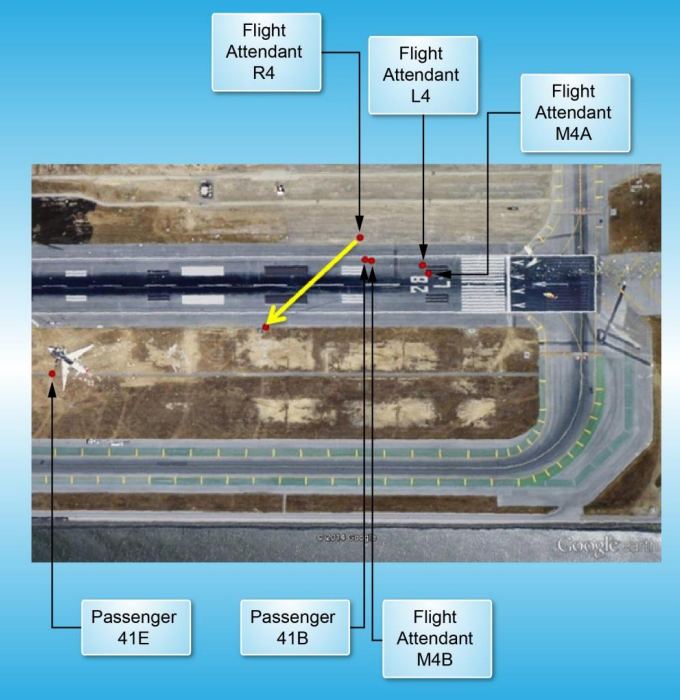
Once the aircraft came to a stop, a fire erupted in the detached right engine, which was positioned beside the right side of the fuselage. One of the flight attendants spotted the blaze and quickly started the evacuation process. Remarkably, 98% of the passengers were able to self-evacuate. However, as the fire progressed and spread throughout the fuselage, firefighters were forced to enter the aircraft to rescue five passengers who were unable to evacuate and had sustained injuries. Unfortunately, one of these passengers later died. Despite this tragedy, it’s important to note that 99% of the occupants survived the crash.
Ten occupants (8 adults and 2 children) in critical condition were admitted to San Francisco General Hospital and a few to Stanford Medical Center. Nine hospitals in the area admitted a total of 182 injured people.
Almost half of the passengers on the flight, specifically 141 individuals, were Chinese citizens. Among these Chinese passengers were 70 students and teachers who were on their way to the United States for a summer camp. Unfortunately, the three passengers who lost their lives during the incident were part of the Jiangshan High School group who were heading to the West Valley camp.

Aircraft Damage and Findings
After the tail struck the seawall short of the runway, the fuselage of the Boeing 777-200ER broke into pieces. This impact resulted in the separation of the tail section and the right engine. The aircraft then spun around and skidded across the runway before coming to a stop.
The right engine, which was located on the wing that struck the seawall, sustained significant damage and caught fire after the aircraft came to rest. The left engine and the landing gear also sustained damage. In addition, the aircraft’s interior was heavily damaged due to the forces of the impact.
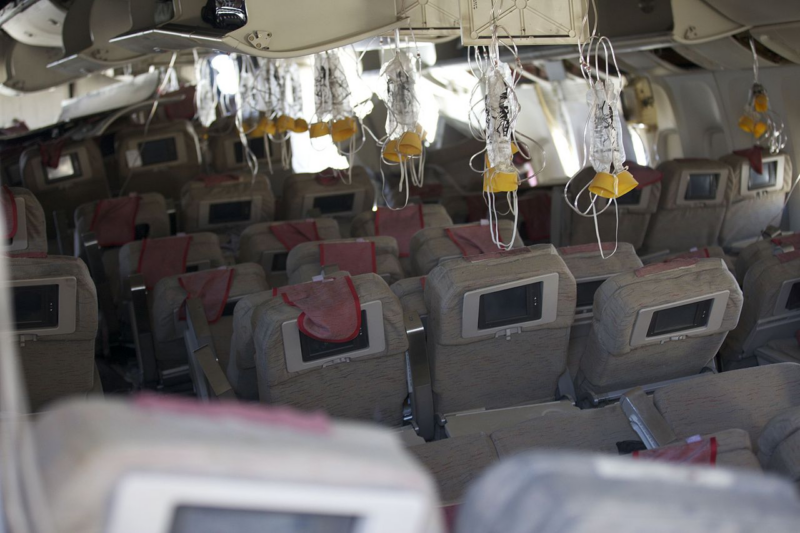
Overall, the aircraft was deemed to be a Hull loss due to the extent of the damage it sustained. Asiana Flight 214 was The Boeing 777’s First Fatal Crash.
The investigation into the accident was led by the National Transportation Safety Board (NTSB). The investigation concluded that the probable cause of this accident was the flight crew’s mismanagement of the aircraft’s descent during the visual approach, the PF’s unintended deactivation of automatic airspeed control, the flight crew’s insufficient monitoring of airspeed, and the flight crew’s delayed decision to execute a go-around after they became aware that the aircraft was below acceptable glide path and airspeed tolerances.
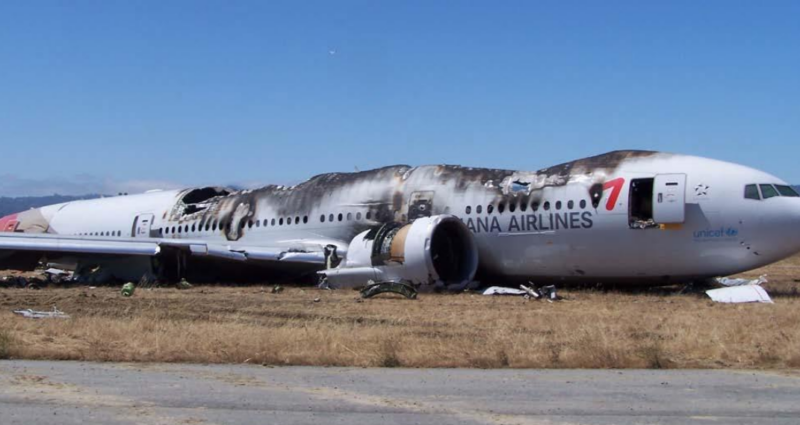
The NTSB investigation identified the following contributing factors:
- The complexities of the autothrottle and autopilot flight director systems were inadequately described in Boeing’s documentation and Asiana’s pilot training, which increased the likelihood of mode error.
- The flight crew’s nonstandard communication and coordination regarding the use of the autothrottle and autopilot flight director systems.
- The PF’s inadequate training on the planning and execution of visual approaches.
- The PM/instructor pilot’s inadequate supervision of the PF.
- Flight crew fatigue, which likely degraded their performance.
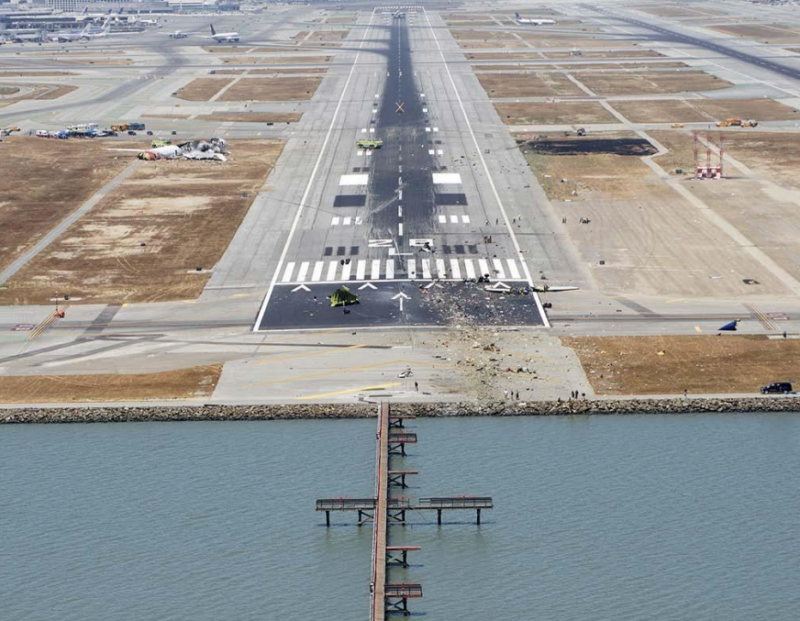
The critical mismanagement of the aircraft’s descent and the lack of attention to the A/T mode ultimately resulted in Flight 214’s devastating crash.
Aftermath
After the crash, San Francisco International Airport was closed for five hours, causing incoming flights to be redirected to other airports in the vicinity. In response to the incident, Asiana Airlines announced that it would retire flight numbers 214 and 213, and instead, operate new flights between Incheon International Airport and San Francisco International Airport under the call signs OZ212 and OZ211, respectively.
Additionally, the Korean airline vowed to enhance the training provided to pilots learning to operate new types of aircraft and improve crew communication and fatigue management to prevent similar incidents in the future.
On August 12, 2013, Asiana announced initial payouts to crash survivors of US$10,000, stating the survivors “need money to go to the hospital or for transportation so we are giving them the $10,000 first.” The families of those who died were paid more than $10,000 as initial compensation, according to Asiana spokeswoman Lee Hyo Min.
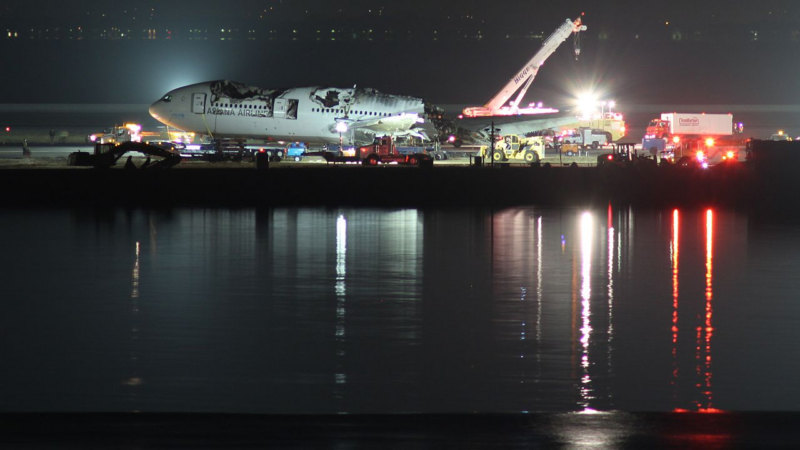
This NTSB investigation further led to the formulation of safety recommendations for several organizations including the FAA, Asiana Airlines, Boeing, the Aircraft Rescue and Firefighting Working Group, and the City and County of San Francisco.
South Korean transport ministry officials mandated that Korean Air and Asiana inspect the engines and landing equipment on all 48 of their 777 aircraft models. The officials also declared that the government would perform special inspections on the eight Korean carriers.
Feature Image: NTSB



